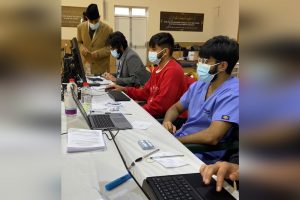
Sinwan Basharat, Canada
As the new year rung in, it came with mixed feelings for the year ahead. For much of the world, the devastating toll of COVID-19 continues to grow and in many parts of the world, the rate of infection is even accelerating. [1] However, there is optimism because vaccines are now being rolled out in different countries. Regulatory authorities in the United Kingdom, Canada and the United States have approved both the Pfizer/ BioTech and Moderna vaccines (see COVID-19 vaccine tracker). These two vaccines were shown to have greater than 90% vaccine efficacy in Phase III clinical trials. [2] [3] Other vaccines are also being approved in different countries.
With these very promising vaccines now at hand, scientists estimate that if 60% to 80% of the world’s population is vaccinated, the spread of COVID-19 can almost entirely be stopped. [4] This will be no easy logistical feat, but leading scientists have another worry as well. There is growing concern that many people will refuse to take any vaccine. [4] [5] Evidence from across the world suggests that nearly 30% of people are hesitant to take any vaccine. [4] [6] In some countries, like France and Russia, that hesitancy is found in more than 50% of the population. [6] [7] Most of the people with low vaccine confidence indicate that they are sceptical about its efficacy and fear harmful side-effects. [7] (Note: these and other concerns are well addressed by the leading Mayo Clinic). [8] Such sentiments of vaccine resistance are not new. Vaccine hesitancy has existed since the very inception of vaccines and also existed more than 120 years ago, during the time of the Promised Messiah (as), when the Indian subcontinent was facing a terrible epidemic, even deadlier than COVID-19. [9-11]
What was the deadly epidemic in the Indian sub-continent at the time of the Promised Messiah (as) and how critical was vaccine hesitancy at the time?
The Plague in British India
In 1893, the Promised Messiah (as) prophesied that a plague would afflict India. [12] Later, in February 1898, he reiterated his prophecy and painted a vivid picture of an impending catastrophe that was to unfold, particularly in the Punjab. [12] While at the time, reports of the plague infection had been reported since the initial cases in 1896, they were only minor occurrences and limited to Bombay, Pune, Calcutta, and Karachi. [13] [14] However, by 1899, the plague had reached epidemic proportions and was spreading rapidly in the western and northern parts of the country. [13] [14]
The British Government implemented a set of stringent measures to help control the disease by enforcing quarantines of infected people, evacuations of homes, and conducting medical inspections of markets. [13] To little avail, the plague continued to ravage the country, taking millions of lives and causing immense devastation to the social, economic, and political fabric of the subcontinent. [11] The Review of Religions describes a chilling account of the situation from 1906 [15] (The full archived article can be read here: Plague and the Prophecy):
‘The havoc which the plague is working in India, especially in the Punjab is appalling. Every attempt to cope with the epidemic has proved an utter failure. The people are now at the mercy of the pestilence, it may rage or ablate at its will, it fears no human interference.’

Worried about the growing epidemic, the British Government hired bacteriologist, W. Haffkine, a pioneer of the first cholera vaccine, to make a vaccine against the plague. [16] [17] In late 1896, he travelled to Bombay and set up his clinic. Within months, Haffkine successfully produced an antidote injection, made from culturing the plague bacteria (called Yersina pestis) [16] [17]. He first tested the injection in animals and then among inmates inside a Bombay prison, showing promising results. The vaccine had an efficacy of 50% to 85% and so production was upscaled. [16] Historical reports from 1901 and onwards detail how the government conducted surveys and then administrated the vaccine in places like the Punjab, where the plague was spreading very quickly. [13]

With the vaccine at hand, it seemed the plague would be contained. However, in 1902, the government’s efforts faced a major setback when in one village, 19 people who had taken Haffkine’s vaccine died. [16] This incident caused immense fear of the vaccine in India and mistrust in the British Government grew. [16] [18] After an investigation, it was finally discovered that one of the batches of vaccine was accidently contaminated by a worker, and not due to any inherent danger of the vaccine. [16] [17] Nonetheless, negative perceptions about the vaccine and other public health measures continued to persist, and many people refused to take the inoculation. [17]

In fact, historical evidence suggests that scepticism and suspicion of the British Government, especially in areas where there was pre-existing opposition to the state, played a major role in perpetuating the plague for so many years. [14] [18] In some regions, family members would refuse to take the ill to hospitals or would conceal reporting plague victims to the authorities. [19] In other parts of the country, many people actively resisted the vaccine, spreading rumours that the vaccine itself poisoned people and was being used by the British to kill Indians. [19] Some religious leaders also forbid the vaccine, telling their followers that it contained animal substances forbidden by their religion. [18] [19]
Trusting Authorities
‘O ye who believe! Obey Allah and obey His Messenger and those who are in authority among you.’ [Holy Quran, 4:60]
In line with the Islamic principle of showing reverence to the state and to government authorities, the Promised Messiah (as) advocated for a much more favourable outlook on the government’s response to the epidemic. During this time of growing distrust and anguish in the country, he particularly commended the British Government’s campaign to vaccinate millions of people. He wrote,
‘Gratitude is due to the eminent British government who, showing kindness to its subjects, has once again advised inoculation against the plague, and has undertaken the expenditure of hundreds of thousands of rupees for the welfare of the servants of God. In truth, it is the duty of wise subjects to welcome this undertaking with gratefulness. Anyone who views the inoculation with mistrust is immensely foolish and is his own enemy, for it has been observed time and again that this cautious government is averse to administering any harmful treatment, and prescribes only remedies that have been thoroughly tested and proven to be effective. It is against the norms of honesty and civility to attribute ulterior motives to a government which has, and continues to spend, hundreds and thousands of rupees and resources out of genuine sympathy for its subjects.
Unfortunate are the subjects who reach such a degree of mistrust. There can be no doubt that until now inoculation is by far the best physical remedy that the government has found, and there is no denying that this remedy has proven to be effective.’ [20]
These words of the Promised Messiah (as) were critical at that time. In 1902, little was known about the plague bacterium or how it was spread, and there was no established cure. The British government had invited the leading expert in the field to try and make an effective vaccine and once it showed promising results, the government invested in its production and administration in areas that were highly exposed. However, distrust in the government’s public health efforts were upending the ability to control its spread. [18] [19] As a prophet of God, the Promised Messiah (as), had genuine compassion for all people. He emphatically dispelled notions of distrust in the government’s efforts to help control the epidemic. Other religious leaders too, in different parts of the country, from the Sikh, Hindu, Christian, and Muslim communities played a role in advocating for cooperation with the authorities and the wider plague control measures. [19] The government later also worked with local medical practitioners to improve education about sanitation and dispel myths about the vaccine. [14] [18] [19]
By 1925, more than 26 million doses of Haffkine’s vaccine had been administered, but the toll the plague had taken was far too devastating. It is estimated that 10 to 12 million people in India may have died from the disease. [11] [12] [16]
Looking Ahead to Vaccine Efforts in 2021
The current COVID-19 epidemic has taken nearly 2 million lives. [1] As vaccines get approved and begin to be rolled out, it will be one of the largest vaccine efforts in history. [21] With some estimates suggesting that nearly one-third of people may be unwilling to get vaccinated, overcoming vaccine hesitancy will be at the forefront of immunization and public health efforts. [4] [21] Building vaccine confidence, however, will require both thoughtful and empathetic approaches. Similar to the plague in British India, research shows that while there can be complex reasons for vaccine hesitancy, these reasons are often linked to an underlying mistrust of government officials or authorities. [22] [23] Therefore, public health officials will need to use culturally sensitive campaigns to restore vaccine confidence, and engage with communities (and their leaders) to address concerns found among people from diverse cultural, religious, and ethnic backgrounds. [6] [9] [23]
As a society, we too will need to collectively advocate for our scientists and regulatory bodies, who have the critical job of ensuring that only safe and effective vaccines are approved. We also need to trust our governments and public health authorities and recognize that it is in their best interests to overcome this devastating virus. We hope this year sees a bright light ahead and soon we too can look at this pandemic through the lens of history, rather than our present reality.
The plague in India was a major prophecy of the Promised Messiah (as), and the full history of its religious significance can be read here: The Plague | Review of Religions
About the Author: Sinwan Basharat is a health researcher with a background in molecular genetics and epidemiology. He works for a Canadian research agency in Ottawa, Canada. He also serves as a Deputy Editor for the Science Section in The Review of Religions.
ENDNOTES
[1] BBC News. Covid-19 pandemic: Tracking the global coronavirus outbreak – BBC News. (2021). Available at: https://www.bbc.com/news/world-51235105. (Accessed: 10th January 2021)
[2] Polack, F. P. et al.Safety and Efficacy of the BNT162b2 mRNA Covid-19 Vaccine. N. Engl. J. Med.2603–2615 (2020). doi:10.1056/NEJMoa2034577
[3] Baden, L. R. et al.Efficacy and Safety of the mRNA-1273 SARS-CoV-2 Vaccine. N. Engl. J. Med.NEJMoa2035389 (2020). doi:10.1056/NEJMoa2035389
[4] Wang, W. et al.Global, regional, and national estimates of target population sizes for covid-19 vaccination: descriptive study. BMJm4704 (2020). doi:10.1136/bmj.m4704
[5] NPR. Fauci: It Would Be Terrible If People Choose Not To Get COVID-19 Vaccine : NPR. (2020). Available at: https://www.npr.org/2020/12/15/946617217/fauci-it-would-be-terrible-if-people-choose-not-to-get-covid-19-vaccine. (Accessed: 10th January 2021)
[6] Lazarus, J. V. et al.A global survey of potential acceptance of a COVID-19 vaccine. Nat. Med. (2020). doi:10.1038/s41591-020-1124-9
[7] Salyer, K. Here’s how global COVID-19 vaccine confidence has changed | World Economic Forum. World Economic Forum(2020). Available at: https://www.weforum.org/agenda/2020/12/covid-19-vaccine-confidence-world-economic-forum-ipsos-survey/. (Accessed: 11th January 2021)
[8] Tanula, M. COVID-19 vaccine myths debunked – Mayo Clinic News Network. (2020). Available at: https://newsnetwork.mayoclinic.org/discussion/covid-19-vaccine-myths-debunked/. (Accessed: 12th January 2021)
[9] Gainty, C. & Arnold-Forster, A. Vaccine hesitancy is not new – history tells us we should listen, not condemn. The Conversation(2020). Available at: https://theconversation.com/vaccine-hesitancy-is-not-new-history-tells-us-we-should-listen-not-condemn-150884. (Accessed: 10th January 2021)
[10] TIME Magazine. The Third Plague Pandemic – Top 10 Terrible Epidemics – TIME. Available at: https://content.time.com/time/specials/packages/article/0,28804,2027479_2027486_2027498,00.html. (Accessed: 10th January 2021)
[11] Frith, J. The history of plague – Part 1. The three great pandemics. J. Mil. Veterans. Health20, 11–16 (2012).
[12] Ahmad, M. U. The Plague | Review of Religions. (2015). Available at: https://rorenglish.wpengine.com/12015/the-plague/. (Accessed: 10th January 2021)
[13] Mushtaq, M. Public health in British India: A brief account of the history of medical services and disease prevention in colonial India. Indian J. Community Med.34, 6–14 (2009).
[14] National Library of Scotland. Plague – Medical History of British India – National Library of Scotland. (2010). Available at: https://digital.nls.uk/indiapapers/plague.html. (Accessed: 10th January 2021)
[15] M. Sher Ali. The Plague and Prophecy | Review of Religions. (1906). Available at: https://rorenglish.wpengine.com/4251/the-plague-and-prophecy/. (Accessed: 10th January 2021)
[16] Genter, J. & Pandey, V. Waldemar Haffkine: The vaccine pioneer the world forgot. BBC News(2020). Available at: https://www.bbc.com/news/world-asia-india-55050012. (Accessed: 10th January 2021)
[17] Hawgood B. Waldemar Mordecai Haffkine, CIE (1860–1930): prophylactic vaccination against cholera and bubonic plague in British India. J. Med. Biogr.15, 9–19 (2007).
[18] Kumbhar, K. India’s Tumultuous History of Epidemics, Religion and Public Health Policy. (2020). Available at: https://thewire.in/health/india-epidemics-religion-public-health-policy. (Accessed: 10th January 2021)
[19] Sarkar, N. Flear, Faith, and Politics: Anatomy of an Indian Epidemic, 1890-1925. (National University of Singapore, 2011).
[20] Noah’s Ark, pg. 1-2, 1902.
[21] The Economist. Vaccinating the world – The great task. Briefing(2021). Available at: https://www.economist.com/briefing/2021/01/09/the-great-task. (Accessed: 10th January 2021)
[22] Murphy, J. et al.Psychological characteristics associated with COVID-19 vaccine hesitancy and resistance in Ireland and the United Kingdom. Nat. Commun.12, 1–15 (2021).
[23] McMaster Health Forum. What is known about strategies for encouraging vaccine acceptance and addressing vaccine hesitancy? – COVID-19 Rapid Evidence Profile. (2020).




This is a highly convincing and compelling analysis of the present situation regarding the vaccines. The media is bombarding the public with conflicting and equally compelling reports.
I think scepticism revolves around the past consequences of some vaccinations such as MMR and BCG. I believe this is more related to the toxic base used for the vaccines.